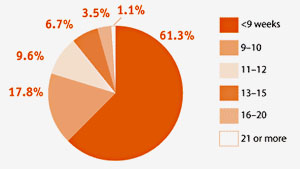 Dana McCourt provides this handy chart showing just what the stakes are in the fight over late-term abortions. If, like me, you think that viability outside the uterus is the best rough measure of whether a fetus is a human being that deserves legal protection, this chart is telling: the absolute lower limit for viability is around 22 weeks, and only about 1% of all abortions are performed that late. Past 24 weeks, according to a footnote later in the post, only about 100 abortions are performed per year. Post-viability abortions are very, very rare, and performed almost exclusively for serious medical reasons.
Dana McCourt provides this handy chart showing just what the stakes are in the fight over late-term abortions. If, like me, you think that viability outside the uterus is the best rough measure of whether a fetus is a human being that deserves legal protection, this chart is telling: the absolute lower limit for viability is around 22 weeks, and only about 1% of all abortions are performed that late. Past 24 weeks, according to a footnote later in the post, only about 100 abortions are performed per year. Post-viability abortions are very, very rare, and performed almost exclusively for serious medical reasons.
Needless to say, if you believe that life begins at conception and are unwilling to accept that personhood is a continuum with some inevitable grayness, this won’t persuade you of anything. For the rest of us, who believe that fetuses become human beings at some point during pregnancy but before birth, it’s worth understanding just how few post-viability abortions there are. And since that 22-week marker is due to fundamental developmental issues related to the brain and the skull, it’s unlikely that scientific advances outside of full-blown artificial wombs will ever have much effect on this.
In any case, no matter how you feel about this, now you know. Late term abortions are very rare things indeed.

















